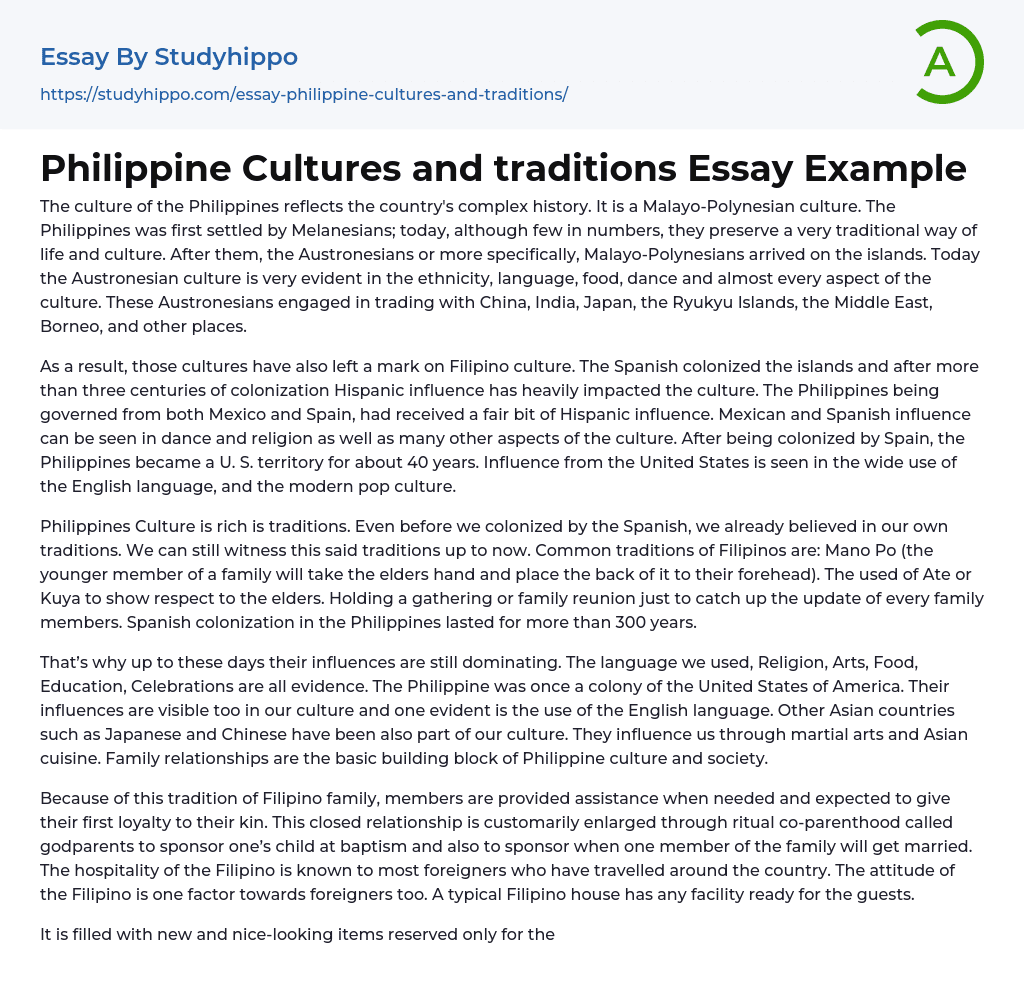The culture of the Philippines reflects the country's complex history. It is a Malayo-Polynesian culture. The Philippines was first settled by Melanesians; today, although few in numbers, they preserve a very traditional way of life and culture. After them, the Austronesians or more specifically, Malayo-Polynesians arrived on the islands. Today the Austronesian culture is very evident in the ethnicity, language, food, dance and almost every aspect of the culture. These Austronesians engaged in trading with China, India, Japan, the Ryukyu Islands, the Middle East, Borneo, and other places.
As a result, those cultures have also left a mark on Filipino culture. The Spanish colonized the islands and after more than three centuries of colonization Hispanic influence has heavily impacted the culture. The
...Philippines being governed from both Mexico and Spain, had received a fair bit of Hispanic influence. Mexican and Spanish influence can be seen in dance and religion as well as many other aspects of the culture. After being colonized by Spain, the Philippines became a U. S. territory for about 40 years. Influence from the United States is seen in the wide use of the English language, and the modern pop culture.
Philippines Culture is rich is traditions. Even before we colonized by the Spanish, we already believed in our own traditions. We can still witness this said traditions up to now. Common traditions of Filipinos are: Mano Po (the younger member of a family will take the elders hand and place the back of it to their forehead). The used of Ate or Kuya to show respect to the elders. Holding a gathering or family reunion just t
catch up the update of every family members. Spanish colonization in the Philippines lasted for more than 300 years.
That’s why up to these days their influences are still dominating. The language we used, Religion, Arts, Food, Education, Celebrations are all evidence. The Philippine was once a colony of the United States of America. Their influences are visible too in our culture and one evident is the use of the English language. Other Asian countries such as Japanese and Chinese have been also part of our culture. They influence us through martial arts and Asian cuisine. Family relationships are the basic building block of Philippine culture and society.
Because of this tradition of Filipino family, members are provided assistance when needed and expected to give their first loyalty to their kin. This closed relationship is customarily enlarged through ritual co-parenthood called godparents to sponsor one’s child at baptism and also to sponsor when one member of the family will get married. The hospitality of the Filipino is known to most foreigners who have travelled around the country. The attitude of the Filipino is one factor towards foreigners too. A typical Filipino house has any facility ready for the guests.
It is filled with new and nice-looking items reserved only for them while ordinary ones are for everyday use. Some foreigners who lived in the Philippines for quiet long time may adopt, and understand this Filipino culture. However, some may find it hard. Filipinos love entertaining foreign visitors, whether to help, or for whatever reason, interacting with them is unavoidable and may bring something to look forward. Aside from the country’s stunning and
natural assets, meeting the Filipinos promises you true friendship and memories to keep.
- Barangay essays
- African American essays
- African American Culture essays
- American Values essays
- Asian American essays
- Chinese essays
- Ethnicity essays
- Ethnocentrism essays
- German essays
- Han Chinese essays
- Hispanic essays
- Identity essays
- Korean essays
- Mexican essays
- Nation essays
- Native American essays
- Race and Ethnicity essays
- White People essays
- Bangladesh essays
- China essays
- Hong Kong essays
- India essays
- Japan essays
- Kuala Lumpur essays
- Malaysia essays
- Manila essays
- Pakistan essays
- Philippines essays
- Singapore essays
- Vietnam essays
- Vietnamese essays




